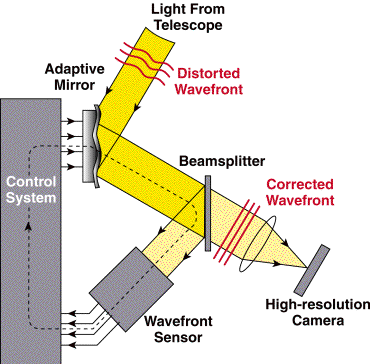ADAPTIVE OPTICS
The earth's atmosphere has undesirable effects on the light that comes
to us from space. These effects can be avoided by placing the
telescope above the atmosphere, such as with the Hubble Space Telescope, or if the
effect can be adequately measured, then we can endevour to correct
it.
Adaptive optics corrects the effect of atmospheric turbulence. The
atmosphere is constantly changing, with warm air rising, cold air
sinking, and winds mixing this all together. Light is affected by the
medium in which it propagates, so starlight passing through the
turbulent atmosphere is disrupted. We see this effect with the naked
eye as the twinkling of the stars. A long exposure image of a star
taken through a telescope reveals this disruption by the fact that the
star looks blurred out and indistinct, especially compared with the
telescope's diffraction
limit, the theoretical limit of the telescope's image resolution.
Adaptive optics, a technique now in routine operation at many of the
world's observatories, enables a telescope to achieve extremely sharp,
essentially diffraction-limited images.
| To understand how adaptive optics
works, imagine the light from the star as waves. When these waves
arrive at the top of the Earth's atmosphere, the wavefronts are essentially
perfectly flat. The turbulent atmosphere crumples the wavefront. If
the telescope receiving the light simply makes an image with this
crumpled wavefront, a blurry image is formed. In adaptive optics, the
crumpled wavefront is reflected off of a deformable mirror, a mirror
with hundreds of small actuators glued to the back of it. The
actuators are commanded to apply the exact shape to the deformable
mirror such that the wavefront, upon reflection emerges flat again,
the way it was before it entered the atmosphere. The result is an
image nearly as good as if the atmosphere were not present. This
system operates in closed loop, measuring the residual error (the
residual crumple left on the wavefront after it has reflected off of
the deformable mirror) using a "wavefront sensor." Because the
atmospheric turbulence rapidly changes, this correction must be
updated thousands of times each second.
The schematic at right appears courtesy of C. Max, Center for Adaptive Optics.
|
 |
Example Wavefronts and Images
On the right is a simulation of uncorrected and corrected wavefronts
and images. On the upper left is a representation of the corrupted
wavefront entering a telescope and corresponding distorted image is
shown below it. The center panel shows the deformable mirror crunched
into the best fit shape to correct the wavedfront. On the right is
the residual errors in the wavefront (top) after reflection off of the
deformable mirror and that wavefront's corresponding image (bottom).
To see this in motion, click on the image to download a 2 MB Mpeg
movie file. |

|
Making the Image Even Better
To see a faint planet next to a bright star, the
wavefront must be carefully controlled. Even small wavefront errors
produce a bright cloud of "speckles" surrounding the star. If the
speckles are brighter than the planets next to the star, then we
cannot see the planet. The image at right shows the effect of
increasing the fidelity of the adaptive optics, by using many more
actuators on the deformable mirror and updating the correction more
rapidly. Since the image is "cleaned up" over a much larger field of
view, the prospects are greatly improved for detecting planets. There
is still a lot of light remaining in the field of view, in the vicinity of the planets orbiting this star, but much of that can be removed with a coronagraph.
Clicking on the image at right will download a 2 MB Mpeg movie file to show this process in motion.
|

|
|



